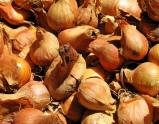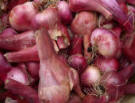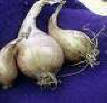Shallots
Information, recipes, and history of Shallots
Â
Â
Â
 Shallots
belong to the plant family Alliaceae which includes other plants such as
chives, leeks, garlic and onions. The main differences between ordinary onions
and shallots are that shallots grow in clusters with the separate bulbs being
much smaller than regular onions, usually up to the size of a golf ball, which
are attached at the base. Once peeled of the outer papery skin, each shallot
divides into cloves in much the same way as garlic. Small shallots will have two
or three individual cloves whilst larger ones can have up to six. Culinary wise,
they have a finer texture and a milder taste than most onions. Shallots
belong to the plant family Alliaceae which includes other plants such as
chives, leeks, garlic and onions. The main differences between ordinary onions
and shallots are that shallots grow in clusters with the separate bulbs being
much smaller than regular onions, usually up to the size of a golf ball, which
are attached at the base. Once peeled of the outer papery skin, each shallot
divides into cloves in much the same way as garlic. Small shallots will have two
or three individual cloves whilst larger ones can have up to six. Culinary wise,
they have a finer texture and a milder taste than most onions.
N.B. There seems to be some confusion about name for shallots, in
particular Green Onions, Scallions, Bunching Onions and Spring Onions. Shallots
are none of the aforementioned, although in some countries they interchange the
names willy nilly � adding to the confusion.
Â
Types,
Origin and History of Shallots
Â
Shallots can be divided into two different types: French Grey or
Griselle genus Allium oschaninii which are considered by many to be the
true shallot and Allium ascalonicum. Grey shallots have a long bulb,
sometimes resembling frogs legs, are covered with grey skin and have a
white/purplish flesh whilst Allium ascalonicum are generally rounder in shape
with a copper/russet or purple coloured skin.
Â
The botanical name ascalonicum is taken from Ascalon, which was a town in
Palestine, where they were thought to have originated, however it is now
believed that they probably came from Asia. Certainly c300 BC the Greek writer
Theophrastus referred to them in writings as did Pliny in the 1st century AD.
They were first introduced to Western European during the 12th Century AD when
Crusaders brought them home from Palestinian.
Â
Cultivation of Shallots
Â
Although shallots are perennials they are best treated as
annuals. Because they are hardy they are excellent for growing in colder
climates and they also cope much better with heat and poorer soils than ordinary
onions. Whilst hey can be grown from seed, better results are usually achieved
using small offset bulbs (sets), which are planted in late autumn for
over-wintering. During the growing period this "mother" bulb will multiply into
a cluster of several bulbs. When planting, the tips of the bulbs should remain a
little above ground. Plant the bulbs root down, 15cm/6-inches apart. Do not
plant in ground which has recently had manure added to it.
They generally reach maturity around July or August, and only require minimal
watering and weeding throughout the growing season plus a feed of general
fertiliser in early spring. Like onions, they are harvested when the leaves
begin to turn brown and wilt.
|
|

 Shallots
belong to the plant family Alliaceae which includes other plants such as
chives, leeks, garlic and onions. The main differences between ordinary onions
and shallots are that shallots grow in clusters with the separate bulbs being
much smaller than regular onions, usually up to the size of a golf ball, which
are attached at the base. Once peeled of the outer papery skin, each shallot
divides into cloves in much the same way as garlic. Small shallots will have two
or three individual cloves whilst larger ones can have up to six. Culinary wise,
they have a finer texture and a milder taste than most onions.
Shallots
belong to the plant family Alliaceae which includes other plants such as
chives, leeks, garlic and onions. The main differences between ordinary onions
and shallots are that shallots grow in clusters with the separate bulbs being
much smaller than regular onions, usually up to the size of a golf ball, which
are attached at the base. Once peeled of the outer papery skin, each shallot
divides into cloves in much the same way as garlic. Small shallots will have two
or three individual cloves whilst larger ones can have up to six. Culinary wise,
they have a finer texture and a milder taste than most onions.

